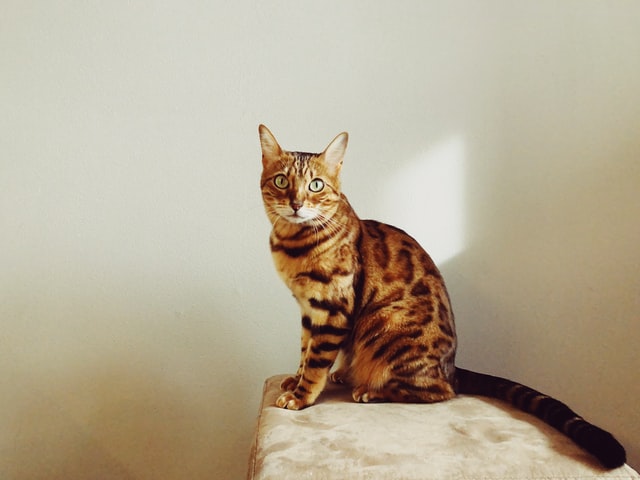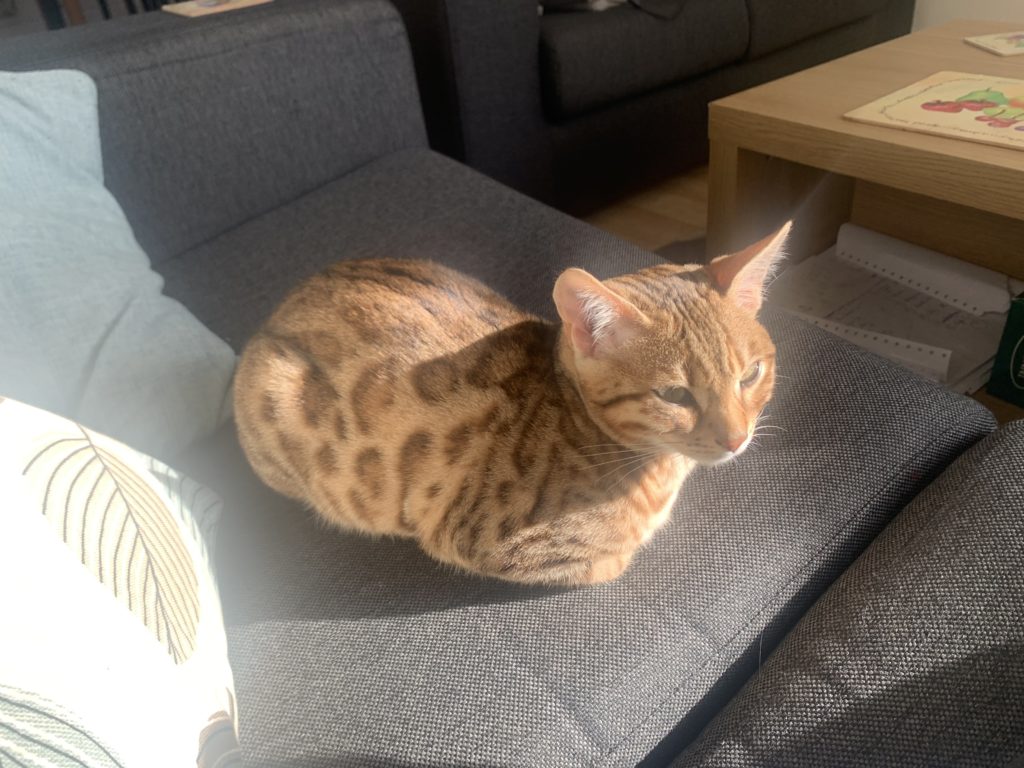Why an air purifier for cat litter?
Well, cat litter can smell.
Or more specifically, the ‘deposits’ in that cat litter can smell, and subsequently, so can your house.
In addition, cat litter dust and particles from trays or litter boxes can easily be ejected into the air.
Air purifiers can go some way to help removing both odours, litter particles and improving air quality.
What You Will Discover
- The best air purifiers to remove cat litter odours and dust
- Factors to consider when buying an air purifier
- Other ways you can help reduce emissions from cat litter
Levoit 300S |
| 4.7/5 from 78,444 ratings | |
Germ Guardian |
| 4.7/5 from 54,187 ratings | |
Levoit LV-H132 |
| 4.6/5 from 46,072 ratings | |
Honeywell HPA300 |
| 4.7/5 from 29,877 ratings | |
Levoit Core 200S |
| 4.7/5 from 28,873 ratings | |
Winix 5500-2 |
| 4.7/5 from 23,323 ratings | |
Levoit LV-H128 |
| 4.6/5 from 22,655 ratings | |
Levoit Vital 100 |
| 4.6/5 from 19,524 ratings | |
Hamilton Beach |
| 4.5/5 from 13,805 ratings |
How I Did My Product Research or ‘Method’
In short, in order to determine the best air purifiers, I’ve looked at products rated 4 stars and above on Amazon and ranked them in order of highest reviews at the time of writing (the ‘wisdom of the crowd‘ theory).
If you can find the same locally however, then do support your local business.
It’s also worth noting, I chose products that were in stock, again at the time of writing.
Please read this page for more detail on how I choose products.
Let’s get to it…
The Best Air Purifiers
Levoit Air Purifier 300S
4.7/5 from 78,444 ratings
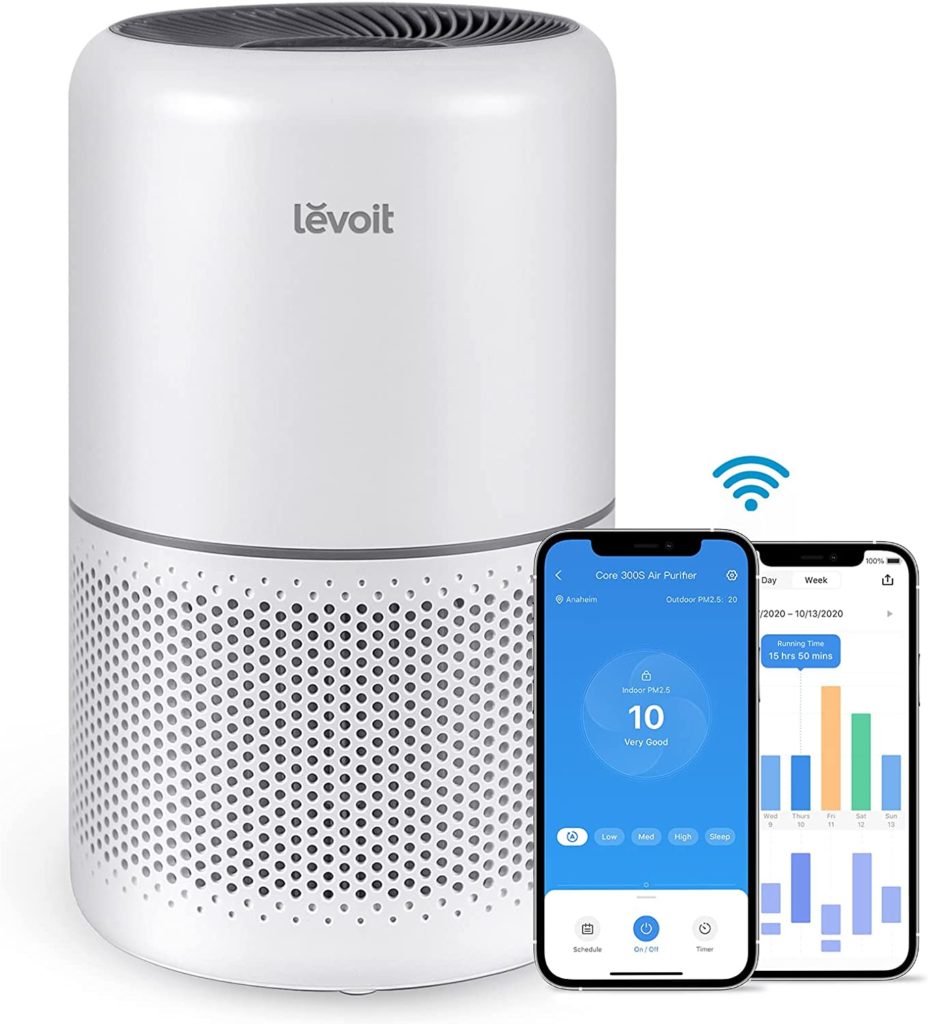
Key Features
- Pre filter, H13 True HEPA and activated carbon filter
- Alexa or Google Assistant control
- VeSync app also allows checking of air quality and setting of schedules
- Auto mode senses changes and adjusts fan speeds and the air quality indicator rings
- Sleep mode automatically turns off display lights and reduces noise levels
- Activated carbon filter helps neutralize odours, smoke, and VOCs
- Low energy DC motor
- Trusted & certified: Based in California ‘The Core 300S’ is Energy Star and FCC certified and ETL listed
- Size: 8.7 x 8.7 x 14 inches
- Room size: 219 ft² room in 12 minutes
- Noise level: 22dB minimum
- CADR: 140 CFM / 238 m³/h
Notes: The first and highest rated of the many Levoit air purifiers that feature on this list. This can be voice activated and ‘smart’ controlled.
Germ Guardian Air Purifier
4.7/5 from 54,187 ratings
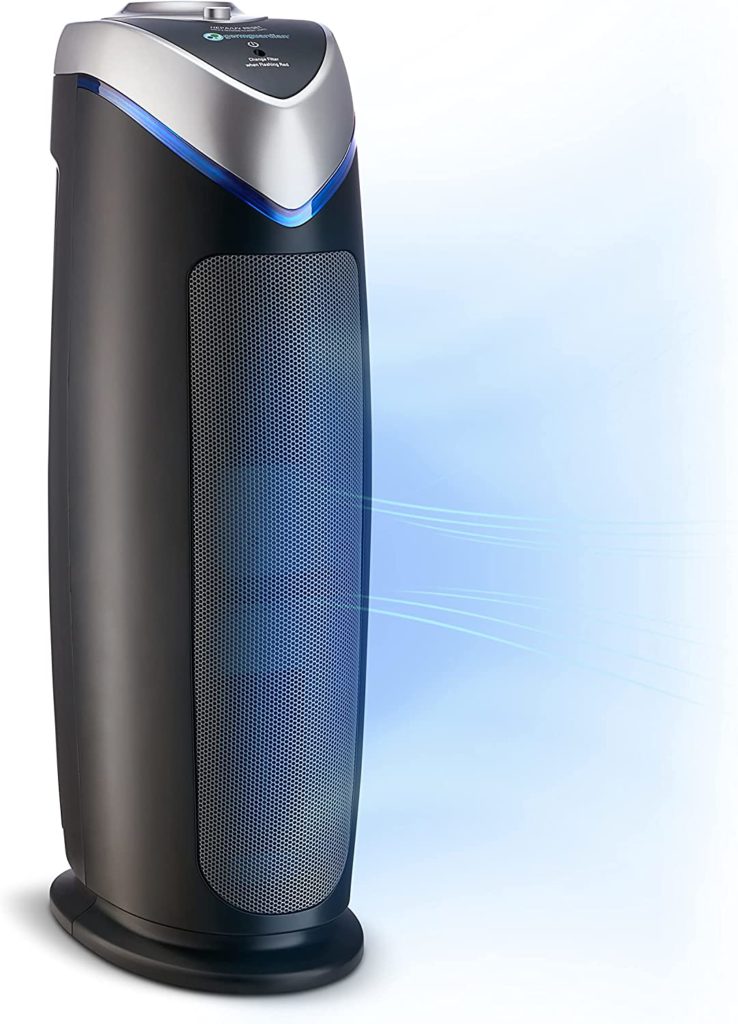
Key Features
- 3 filters
- True HEPA air filter
- UV-C light helps kill airborne viruses such as influenza, staph, rhinovirus and works with titanium dioxide to reduce volatile organic compounds
- Pre-filter traps dust, pet hair, and other large particles while extending the life of the HEPA filter
- Activated charcoal filter
- Lowest setting can be used as gentle white noise to aid sleep
- Size: 10.25 x 6.75 x 21.5 inches
- Room Size: 4.8 air changes per hour in 153 ft² room
- Noise Level: Not stated
- CADR: Smoke 99/Dust 118/Pollen 125
Notes: Contains the 3 main filter types, and according to a question asked on Amazon, the UV-C light does not create ozone. Available as a 2 pack and in white.
Levoit LV-H132 Air Purifier with Optional Night Light
4.6/5 from 46,072 ratings
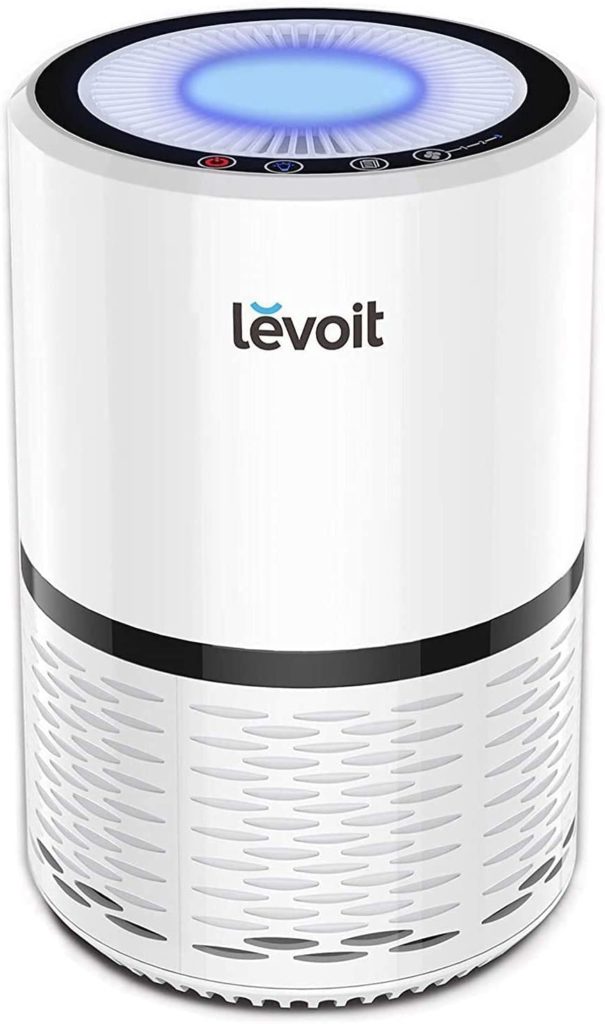
Key Features
- Uses 3-stage H13 True HEPA filtration
- Pre, activated carbon and HEPA filters
- Noise levels as low as 25dB
- Can refresh the air in rooms as large as 129 ft² in 15 minutes.
- Select from two night light brightness settings
- Size: 7.9 x 7.9 x 12.6 inches
- Room Size: 129 ft² room in 15 minutes
- Noise Level: 25dB minimum
- CADR: Not stated
Notes: Smaller than the Levoit 300s (number 1 on this list) but I could not find the CADR so hard to make a direct comparison between the two.
Honeywell HPA300 HEPA Air Purifier
4.7/5 from 29,877 ratings
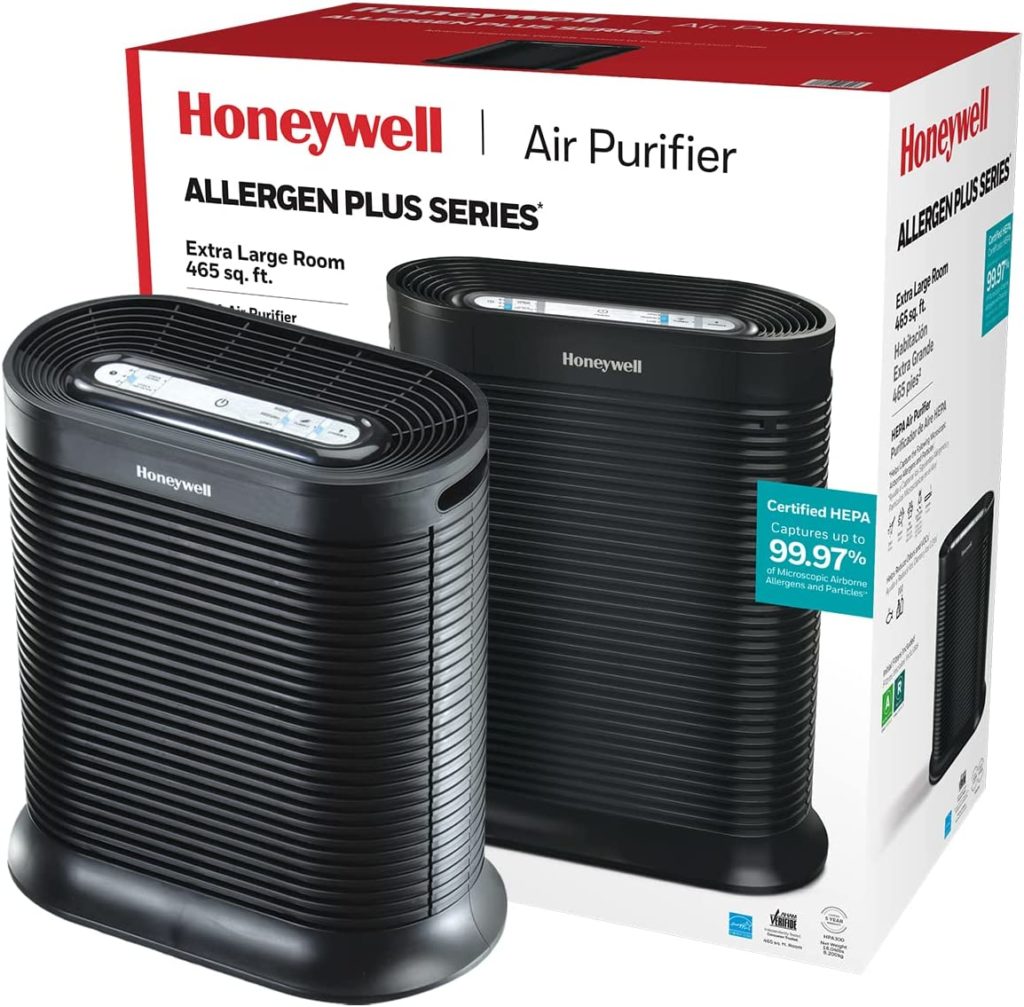
Key Features
- Activated carbon filter and HEPA filter
- 3 air cleaning levels including ‘turbo clean’
- Earned the ‘Energy Star’ label by meeting energy efficient guidelines set by the U.S. EPA.
- Size: 20 x 10.8 x 22.3 inches
- Room Size: Refreshes a 465 ft² room 4.8 times an hour
- Noise Level: 60dB
- CADR: Not stated
Notes: This unit is advertised as being suitable for an extra large room, but large room and medium room versions are also available. Can buy it in white if that’s preferential to black.
Levoit Air Purifier Core 200S
4.7/5 from 28,873 ratings

Key Features
- Nylon pre-filter, activated carbon filter and H13 true HEPA filter
- Use the in-app feature to monitor your filter life
- 360° design
- Lights can be deactivated at night
- With the VeSync app, air purifier can be controlled from anywhere
- Compatible with Amazon Alexa and Google Assistant, allowing voice control
- Can program timers or create customized schedules
- Easy setup via the app
- ETL listed, FCC certified, CARB certified, and compliant with California’s strict standards for indoor cleaning devices
- Power Supply: AC 120V/60Hz (only applies to the USA and Canada)
- Size: 8.07 x 8.07 x 12.6 inches
- Room Size: Ideal room size 183 ft² refreshing air 5x per hour
- Noise Level: Minimum 24dB
- CADR: Not stated
Notes: Similar to the Levoit 300s but seems suited to slightly smaller rooms.
Winix 5500-2 Air Purifier
4.7/5 from 23,323 ratings
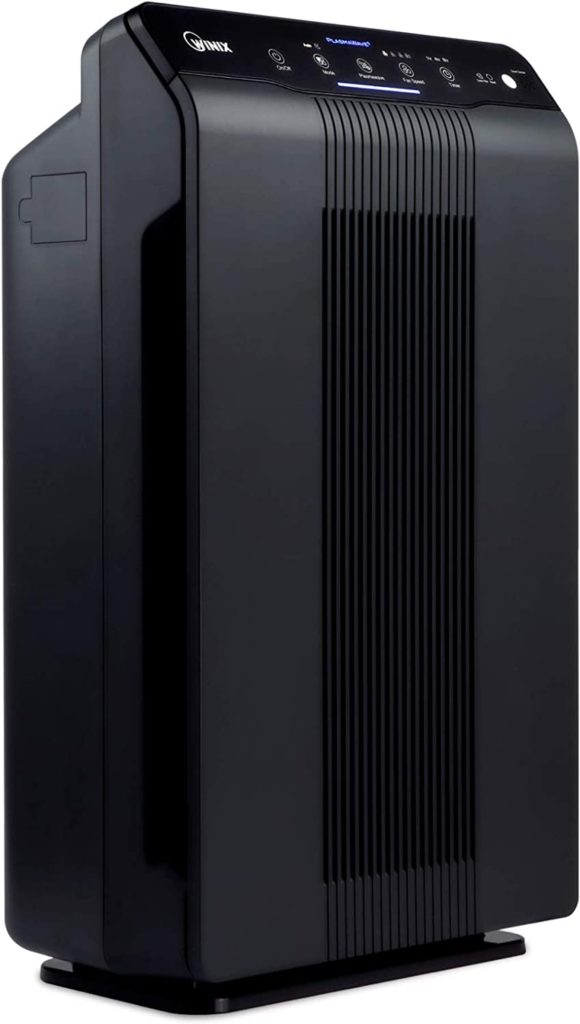
Key Features
- True HEPA filter
- Washable AOC carbon filter, made from activated carbon
- ‘PlasmaWave’ acts as a permanent filter to safely break down odour, allergens, chemical vapors and other pollutants with no harmful ozone
- Smart sensors gauge the air and auto mode adjust the fan to filter the air as needed
- Sleep mode for silent night time operation
- Product has no extra filters
- Size: 8.07 x 8.07 x 12.6 inches
- Room Size: Not stated
- Noise Level: 27.8dB
- CADR: Not stated but CADR rated for room size of 360 ft²
Notes: PlasmaWave seems to act in a similar manner to a carbon filter. Sounds pretty cool too.
Levoit LV-H128 Desktop Air Purifier
4.6/5 from 22,655 ratings
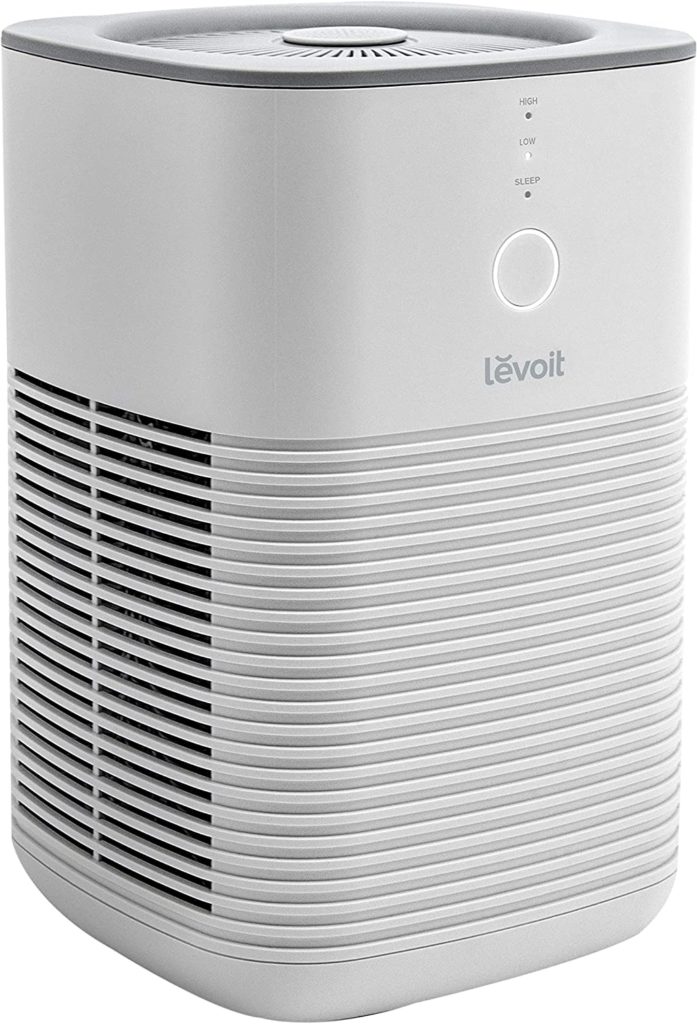
Key Features
- 3-stage filtration system with dual-sided H13 True HEPA filters
- Pre, HEPA and carbon filter
- Noise levels as low as 28dB with a sleep mode
- Includes an aroma pad to add essential oils to for a fragranced room (see notes below)
- One button controls the air purifier and lets you know when the filter needs checking
- Size: 6.7 × 6.7 × 10.4 inches
- Room Size: Refreshes air every 30 minutes in 161 ft² room
- Noise Level: Minimum 28dB
- CADR: Not stated
Notes: In turns out many essential oils are actually toxic to cats so the ‘aroma pad’ feature here may best be left unused. For more on this, there’s a section on essential oils and cats in the article ‘The Best Cat Shampoos For All Needs [2022]‘.
Levoit Vital 100 Air Purifier
4.6/5 from 19,524 ratings

Key Features
- Washable pre-filter, a high-efficiency activated carbon filter and an H13 true HEPA filter
- Display lights can be turned off at night
- Timer
- Indicator tells you when filters need changing
- Size: 6.4 x 12.8 x 11.8 inches
- Room Size: Refreshes air in a 300 ft²/28 m² in 18 minutes
- Noise Level: Minimum 23dB
- CADR: 130 CFM/221 m3/h
Notes: This Levoit offering is aimed at larger rooms than the others featured on this list.
Hamilton Beach Air Purifier
4.5/5 from 13,805 ratings
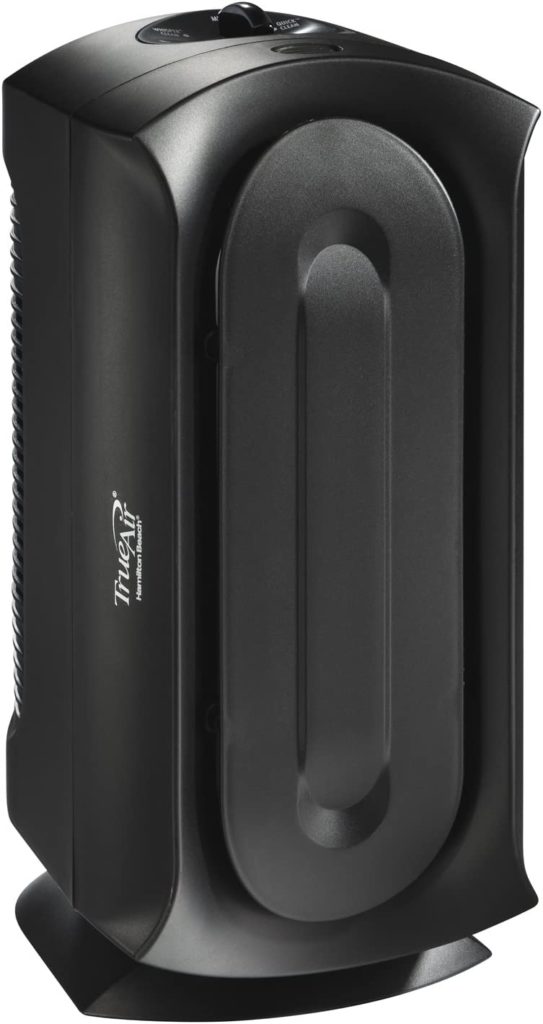
Key Features
- High performance HEPA grade filter that can be vacuum cleaned
- Position the unit vertically or horizontally
- Three speed settings- ‘whisper’ clean (for extra quiet operation at night), the medium setting or the quick clean setting for more powerful air cleaning
- Size: 6 x 8.5 x 13.5 inches
- Room Size: Suitable for rooms up to 160 ft² in size
- Noise Level: Not stated
- CADR: Not stated
Notes: Seems more basic compared to the other air purifiers owing to the fact it only features a HEPA filter- so perhaps best avoided if you’re keen on an air purifier to reduce cat litter odours. Its ability to function both vertically or horizontally could prove beneficial though.
How Does A Cat Litter Air Purifier Work?
Put simply, they remove particles from the air, thus cleaning or purifying it.
These particles include dust, pollen, pet dander, spores, volatile organic compounds (VOCs) bacteria and viruses.
In the case of cat litter then, you will want an air purifier to remove dust and particles from the litter that cause odour.
The mechanism of purification relies on air being sucked through a filter (although filter-less purifiers do exist also) which traps the ‘undesirables’ returning clean air into the environment.
Air purifiers feature different kinds of filter, each with different roles, which we will discuss next…
Air Purifier Filter Types
Successful filtration of air requires a suitable filter or filters.
The purifiers mentioned in this article mainly feature those listed below:
HEPA Filter
HEPA stands for ‘high efficiency particulate air’ filter.
These are, in theory, capable of removing 99.97% of particulates that are airborne and 0.3 microns (that is 0.0003mm) in size or larger.
Logically, larger particles are more likely to be filtered out.
So in theory, dust from a litter tray alongside anything else of cat origin that’s in the air and 0.3 microns or larger should get trapped in a fully functioning HEPA air filter.
All models listed in this article are fitted with a HEPA filter.
Carbon Filter
Carbon filters are made from ‘activated’ carbon (carbon that has been treated to have its surface area increased) although you may also see the term activated charcoal.
They function in a different manner to HEPA filters using a process called adsorption.
This means particles and gases, vapours and volatile organic compounds in the air bind to the activated carbon filter surface rather than being sucked into and trapped in a mesh.
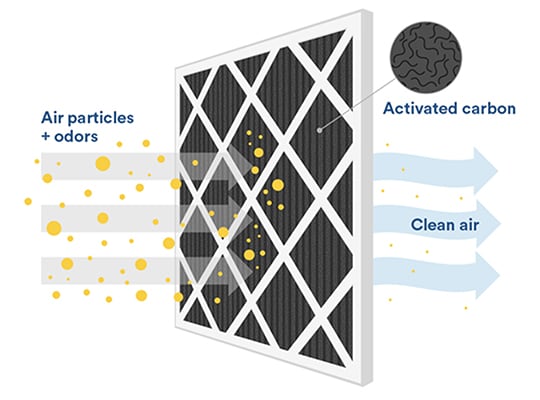
The most effective activated carbon filter is one which is more porous, as a greater surface area allows for greater binding capacity.
Carbon filters are the preferred option for those seeking an air purifier capable of eradicating (or at least reducing) cat litter box odour emanating from the litter tray or pet odours in general.
This site suggests carbon filters aren’t suited to removing pet dander or allergens which is why they should be partnered up with a true HEPA filter.
However, other sites, like this one, contradict that statement.
UV-C Light
Some of the purifiers listed here contain UV-C light filters.
Ultraviolet (UV) light can be used as a means of sterilisation, in that it can kill pathogens such as bacteria and viruses.
The function of a UV-C light filter is the same- to inactivate these when airborne by breaking their protein coats or outer walls- although there is some debate to their actual efficacy in an air filtration system.
If the purpose of your purifier is to remove lingering dust and litter box odour from a cat litter tray, then a UV-C filter is not really required.
Additionally, UV light at wavelengths below 240nm produce ozone as a by-product which can create respiratory problems.
However, this site suggests UV-C lamps should not produce ozone.
The type of filter an air purifier is fitted with is very important, but there are other factors to also consider…
Factors To Consider When Choosing An Air Purifier
You will want an air purifier that meets your needs whether that be removing cat litter dust, odours or anything else cat or non-cat related.
The following should be considered:
Filter Type
The filter type you should aim for will depend on your requirement.
For things like litter dust and cat or pet dander, a HEPA air filter will suffice.
For anything odour related, then a cat litter air purifier fitted with an activated carbon filter should be sought after, probably alongside a HEPA filter.
The effectiveness of UV-C filters is questionable in air purifiers, as it seems, HEPA filters are just as good, if not better.
Location and Room Size
Location, location, room size.
An air purifier will clearly work more effectively the closer to the source it is.
This is because it will be able to trap more particles and odours before they get the opportunity to circulate.
Therefore, placing an air purifier near your cat litter box is preferential.
However, the size of the room you decide to put your purifier in is also important.
Each model (as stated by the manufacturer) has a maximum room size deemed appropriate for it to suitably clean the air.
With this mind, you will be best off either buying a purifier adequate for the size of the room, or moving the litter box to a room which will allow the purifier to work most effectively.
What does CADR mean?
CADR stands for ‘Clean Air Delivery Rate’ which is a measure of how effective an air purifier is at cleaning the air. The scale used depends on the particle size being removed with ratings ranging between 0-400 for smoke and 0-450 for dust and pollen.
A good CADR rating is one which is equal to a minimum of two-thirds the size of the room the purifier is in.
Therefore, a room measuring 10 feet by 9 feet (or 90 square feet) would require an air purifier with a CADR rating of 60 or above to be considered efficient.
The higher the CADR, the faster the unit will be at purifying the air.
Noise
Being electric, motorised appliances, air purifiers do create noise when in operation.
Most models state their functioning noise levels in decibels (dB)
Obviously, the lower this figure, the quieter the purifier.
Some have modes that allow for quieter running, which are especially pertinent if you’re considering placing one in a bedroom.
Conversely, some people actually like the humming noise created by a purifier as it aids sleep.
Noise may not be a big issue in your home if you’re to place your purifier in a room where you’re unlikely to need a quiet environment.
Cost
This is a 3-fold factor.
Firstly, there is the initial outlay required for the unit.
Secondly, running costs in terms of electricity usage- some manufacturers state what this is likely to be according to the intensity of usage.
The final cost to consider is that associated with replacing filters.
It’s hard to say exactly how often a filter will need to be replaced (as it depends on the intensity of use and how unclean the environment is) although some HEPA air filters can be washed.
Manufacturers will claim you should replace filters with their own brand to maintain performance, but whether you do so of course is entirely up to you as you may be able to find (cheaper) alternatives.
Upkeep and Cleaning
This usually involves maintaining the effectiveness of the filters through washing or vacuuming them.
Instructions will be included outlining any maintenance that’s required.
Additionally, some units have indicator lights telling you filters need to be attended to or replaced.
An air purifier can also bring non-cat litter related benefits to your home, which we will look at next.
Other Benefits Of Using An Air Purifier
Additional benefits can be derived from your air purifier depending on its function, or more specifically, the function of the filters.
Allergy sufferers should look for a unit with a true HEPA filter as not only should these be capable of improving air quality by filtering out allergens such as pollen and spores from the air, but also cat or pet dander and rogue, free-floating hairs.
The following paper discusses the use of air purifiers to relieve allergy symptoms: Effectiveness of the Air Purification Strategies for the Treatment of Allergic Asthma: A Meta-Analysis – PubMed (nih.gov)
For more on cats and allergies please read ‘Are Bengal Cats Hypoallergenic? 5 Big Myths Explored.’
Although Bengal orientated, it does discuss cat allergies in general too.
Plus, there’s ample information on the Allergy UK website.
As already touched on, the low hum of a purifier can aid some with sleeping.
With regards to cat litter though, an air purifier may be an expensive solution to a problem that can be minimised in other ways…
11 Quick Tips on Reducing Litter Tray Odours and Dust
Below is a list of things you can and perhaps should try before or alongside investing in an air purifier to reduce dust and litter box odour.
1. Locate the Source
Firstly, be sure any litter box smells are definitely emanating from the litter tray.
Cats, if there’s a problem, can sometimes toilet outside the litter box (see 7 BIG Reasons Why Your Bengal Cat Is Spraying [and how to stop it]) so identifying the source is the important first step to elimination.
2. Remove Waste and Soiled Litter
If it is indeed an unpleasant smelling litter tray, and it most likely will be, then your first task should be to remove any faeces or soiled litter.
The former should be easy enough to spot, however, identifying soiled litter could well depend on the type of litter you use.
Clumping litter, like clay, absorbs waste material and binds together in clumps when soiled so is easier to spot and remove.
Non-clumping litter, like wood chip, may change colour or degrade after being called into action, but it’s harder to identify that which needs removing, and more often than not, it’ll be impossible to remove all that’s been contaminated.
3. Try Different Litter
Clumping litter is supposed to better at controlling box smells owing to increased absorption capacity.
Therefore, switch to clumping litter for better odour control and to make soiled litter removal that much easier.
We currently use a combination of both- clumping clay litter at the bottom of the tray with woodchip on top it’s this type of litter our cat is/was familiar with.
If litter dust is your problem, there are several ‘dust free’ or virtually dust free litter brands to try such as the top rated (in stock) one below :

4. Clean The Tray or Box Itself
If your cat is anything like mine, it tends to use the edges of the box.
This mean that particularly faecal waste often sticks and dries to the inside wall.
No only can this be harder to remove but can help create an ‘odour rich’ environment.
By cleaning the tray itself or anything visible that may have stuck to the sides, you will help ensure it is not contributing to a cat odour problem.
5. Remove and Replace Soiled Litter
There are no set rules here, but more often is better if trying to control box smells.
Fresh faeces and urine are more pungent and scent from these tends to less detectable by human noses over time.
But regular cleaning of the litter and tray is the best possible solution to removing odours before they spread too much.
For best results, this means, cleaning once used.
However, this method may not be practical for everyone- even changing/cleaning on daily basis may be too much.
In which case consider ‘self-cleaning trays’ which you can find more about in this article.
6. Invest in a Larger Litter Box
Put simply, a larger tray means more space and more litter to fill that space.
This should encourage your cats to avoid using and soiling the sides of the box.
Additionally, deeper more abundant litter should do a better job at covering waste and suppressing odours.
The further away from the entrance or sides your cat goes, the less likely dust will be kicked onto the surrounding floor.
7. Use More Litter Boxes
This can be looked at two ways.
More trays and litter boxes should encourage your cat to divide its toilet time between them.
Therefore, you will, in theory, no longer need to clean your tray as often and have less odour and dust coming from one area.
The flip side is that the problem could be exacerbated as multiple trays means multiple cat odour and dust emitting areas which could cover larger portions of your house.
8. Change the Litter Tray Location
If space permits, move your litter tray to areas where odours and dust will be less intrusive and more tolerable.
We have ours in a corner of the hallway.
If we close the living room door, damage is minimal (in terms of odour)- providing we’re in the living room of course.
Although the problem may persist, at least it won’t persist in a room you frequent as often.
If you do decide to relocate your litter tray, remember to ‘show’ your cats where it now lies to avoid any accidents.
9. Use Enclosed Boxes
Litter boxes (like the one pictured below) are supposed to provide some form of odour and dust emission control.
Owning a couple myself, I would say yes in terms of dust.
Questionable in terms of odour.
If you have a basic, open tray, I suppose there’s no harm in trying an enclosed or high-backed version (see ‘List of 7 Bengal Cat Litter Boxes You Can Buy Today‘)
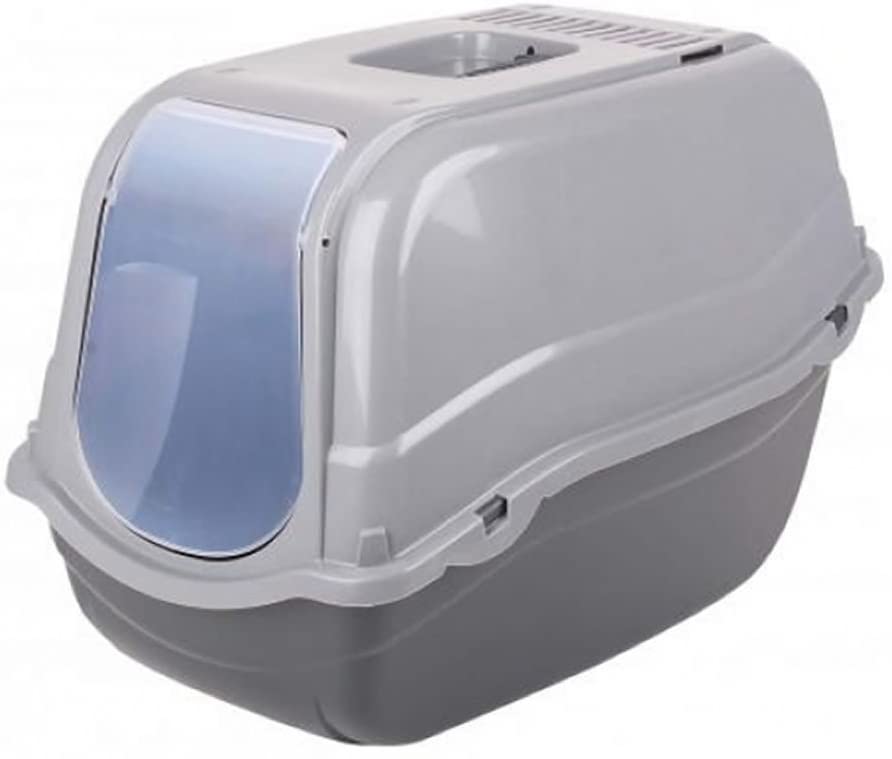
10. Mix Baking Soda into the Litter
Baking soda, being alkaline, is said to neutralize some acids that contribute to pungent odours.
Therefore, some sites suggest adding baking soda to cat litter.
Of course, this will do nothing to prevent dust problems, and being a powder, may actually add to it.
11. Let Your Cat Go Outside
The only definitive way of eliminating litter tray odours and dust all together is for your cat to not use it and go outside instead.
Or course, it’s not possible for everyone to let their cat out.
But those that do, may find the use of the litter tray reducing over time.
Less litter tray use equals less dust and odour problems.
And less cleaning.
Air Purifiers For Cat Litter Summary
As all cat owners know, cat litter tray ejections in terms of cat odour, dust or anything else are not pleasant and can linger.
But you can take action.
Placing a suitable cat litter air purifier with appropriate filters near to a tray can help reduce smells and remove dust from the air.
They can provide the added benefit of filtering out airborne allergens, improving overall air quality.
There are a list of low cost actions you can take too such as regular cleaning of the tray, moving it to a different location or trying an alternative type of litter.
Or simply and probably the most effective solution of all- encourage your cat to conduct its business outside the home.
Take a look and see if you find a unit suitable.
Further Reading:
Please note, Amazon links on this page are affiliate links from which I’ll receive a small percentage if you purchase at no extra cost to you. It all helps. Thanks.

![The Best Air Purifiers For Cat Litter Odours [and dust]](https://thatbengalcat.com/wp-content/uploads/2022/11/Levoit-Core-200s-Air-Purifier-1.jpg)









